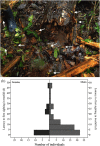From habitat use to social behavior: natural history of a voiceless poison frog, Dendrobates tinctorius
- PMID: 31576237
- PMCID: PMC6753930
- DOI: 10.7717/peerj.7648
From habitat use to social behavior: natural history of a voiceless poison frog, Dendrobates tinctorius
Abstract
Descriptive studies of natural history have always been a source of knowledge on which experimental work and scientific progress rely. Poison frogs are a well-studied group of small Neotropical frogs with diverse parental behaviors, distinct calls, and bright colors that warn predators about their toxicity; and a showcase of advances in fundamental biology through natural history observations. The dyeing poison frog, Dendrobates tinctorius, is emblematic of the Guianas region, widespread in the pet trade, and increasingly popular in research. This species shows several unusual behaviors, such as the lack of advertisement calls and the aggregation around tree-fall gaps, which remain poorly described and understood. Here, we summarize our observations from a natural population of D. tinctorius in French Guiana collected over various field trips between 2009 and 2017; our aim is to provide groundwork for future fundamental and applied research spanning parental care, animal dispersal, disease spread, habitat use in relation to color patterns, and intra-specific communication, to name a few. We report sex differences in habitat use and the striking invasion of tree-fall gaps; describe their courtship and aggressive behaviors; document egg development and tadpole transport; and discuss how the knowledge generated by this study could set the grounds for further research on the behavior, ecology, and conservation of this species.
Keywords: Agonistic behavior; Amazon; Courtship; Habitat use; Parental care; Tadpole transport; Treefall.
© 2019 Rojas and Pašukonis.
Conflict of interest statement
The authors declare that they have no competing interests.
Figures









Similar articles
-
Mind the gap: treefalls as drivers of parental trade-offs.Ecol Evol. 2015 Aug 28;5(18):4028-36. doi: 10.1002/ece3.1648. eCollection 2015 Sep. Ecol Evol. 2015. PMID: 26445657 Free PMC article.
-
Poison in the nursery: Mercury contamination in the tadpole-rearing sites of an Amazonian frog.Sci Total Environ. 2024 Feb 20;912:169450. doi: 10.1016/j.scitotenv.2023.169450. Epub 2023 Dec 21. Sci Total Environ. 2024. PMID: 38135067
-
Pool choice in a vertical landscape: Tadpole-rearing site flexibility in phytotelm-breeding frogs.Ecol Evol. 2021 Jun 15;11(13):9021-9038. doi: 10.1002/ece3.7741. eCollection 2021 Jul. Ecol Evol. 2021. PMID: 34257942 Free PMC article.
-
Frank Beach Award Winner: Lessons from poison frogs on ecological drivers of behavioral diversification.Horm Behav. 2020 Nov;126:104869. doi: 10.1016/j.yhbeh.2020.104869. Epub 2020 Oct 14. Horm Behav. 2020. PMID: 33039350 Review.
-
The big potential of the small frog Eleutherodactylus coqui.Elife. 2022 Jan 14;11:e73401. doi: 10.7554/eLife.73401. Elife. 2022. PMID: 35029143 Free PMC article. Review.
Cited by
-
Exploring links between personality traits and their social and non-social environments in wild poison frogs.Behav Ecol Sociobiol. 2022 Jul 4;76:93. doi: 10.1007/s00265-022-03202-9. Behav Ecol Sociobiol. 2022. PMID: 38989132 Free PMC article.
-
How far do tadpoles travel in the rainforest? Parent-assisted dispersal in poison frogs.Evol Ecol. 2019;33(4):613-623. doi: 10.1007/s10682-019-09994-z. Epub 2019 Jul 5. Evol Ecol. 2019. PMID: 31404198 Free PMC article.
-
Size-dependent aggression towards kin in a cannibalistic species.Behav Ecol. 2022 Mar 25;33(3):582-591. doi: 10.1093/beheco/arac020. eCollection 2022 May-Jun. Behav Ecol. 2022. PMID: 35592877 Free PMC article.
-
Genome Assembly of the Dyeing Poison Frog Provides Insights into the Dynamics of Transposable Element and Genome-Size Evolution.Genome Biol Evol. 2024 Jun 4;16(6):evae109. doi: 10.1093/gbe/evae109. Genome Biol Evol. 2024. PMID: 38753031 Free PMC article.
-
Developments in Amphibian Parental Care Research: History, Present Advances, and Future Perspectives.Herpetological Monographs. 2020 Jul 15;34(1):71-97. doi: 10.1655/HERPMONOGRAPHS-D-19-00002.1. Herpetological Monographs. 2020. PMID: 38989507 Free PMC article.
References
-
- Alvarez-Berríos NL, Aide TM. Global demand for gold is another threat for tropical forests. Environmental Research Letters. 2015;10(1):014006. doi: 10.1088/1748-9326/10/1/014006. - DOI
-
- Amézquita A, Flechas SV, Lima AP, Gasser H, Hödl W. Acoustic interference and recognition space within a complex assemblage of dendrobatid frogs. Proceedings of the National Academy of Sciences of the United States of America. 2011;108(41):17058–17063. doi: 10.1073/pnas.1104773108. - DOI - PMC - PubMed
-
- Anderson JGT. Why ecology needs natural history. American Scientist. 2017;105(5):290. doi: 10.1511/2017.105.5.290. - DOI
Associated data
LinkOut - more resources
Full Text Sources

